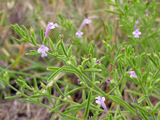Native Plants

Q. Who is Mr. Smarty Plants?
A: There are those who suspect Wildflower Center volunteers are the culpable and capable culprits. Yet, others think staff members play some, albeit small, role. You can torture us with your plant questions, but we will never reveal the Green Guru's secret identity.
Did you know you can access the Native Plant Information Network with your web-enabled smartphone?
Ask Mr. Smarty Plants is a free service provided by the staff and volunteers at the Lady Bird Johnson Wildflower Center.

rate this answer
Friday - November 07, 2014
From: Angleton, TX
Region: Southwest
Topic: Plant Identification, Herbs/Forbs
Title: Identity of blue sage-like plant blooming in September in Lubbock TX
Answered by: Nan Hampton
QUESTION:
This has bothered me for years. It looks like a miniature version of Salvia azure. About a foot talk with multiple stems. Flowering in September. Grows on the hillsides overlooking Buddy Holly Lake in Lubbock. Grows with blackfoot daisy, blue gramma and feathered dalea. Looks biennial to perennial. It's not a skullcap. Thank you.ANSWER:
Since you say it isn't Salvia azurea (Pitcher sage) (USDA Plants Database distribution map shows it occurring in adjacent Lamb County although not in Lubbock County) or Scutellaria resinosa (Resin-dot skullcap) ( USDA Plants Database distribution map shows it occurring in Lubbock County), Mr. Smarty Plants is left with only a few choices that are native and in the Family Lamiaceae (mint family) with flowers that would resemble Salvia azurea. (You will note that I interpreted "blue" rather broadly, including "purple" and "violet" in my search terms as well). They are:
- Hedeoma drummondii (Drummond's false pennyroyal) USDA Plants Database distribution map shows it occurring in Lubbock County. Here are more photos and information from Southwest Colorado Wildflowers.
- Salvia reflexa (Lanceleaf sage) USDA Plants Database distribution map shows it occurring in Lubbock County.
There are three native species of Monarda that occur in Lubbock County, although I don't think they really fit your description. They are
Monarda pectinata (Pony beebalm)
Monarda citriodora (Lemon beebalm)
Monarda clinopodioides (Basil beebalm)
There is one other possibility in the mint family, Lamium amplexicaule (Henbit), an introduced non-native species, that is shown occurring in Lubbock County on the USDA Plants Database distribution map. Here are more photos of henbit from Identify That Plant.
Here are a few possibilities from the Family Scrophulariaceae (Figwort Family) that has flowers that are similar in structure to the mint family flowers.
Nuttallanthus texanus (Texas toad-flax) The USDA Plants Database distribution map shows it occurring in Lubbock County. it normally blooms February through May.
Penstemon buckleyi (Buckley's penstemon) blooms in April-May. The USDA Plants Database distribution map shows it occurring in Lubbock County.
Penstemon fendleri (Fendler's penstemon) blooms April through July. The USDA Plants Database distribution map shows it occurring in Lubbock County.
If none of the above is the plant you saw in bloom in September and you have a photograph or photographs, please visit our Plant Identification page to find links to several plant identification forums that will accept photos of plants for identification. You might also consider contacting someone in the South Plains Lubbock Chapter of the Native Plant Society of Texas to see if they can help you identify the plant.
From the Image Gallery
More Herbs/Forbs Questions
Shade tolerant Wildflowers for Oklahoma City
April 16, 2012 - I live in Oklahoma City. I'm not in town very often, and am seeking low maintenance plants. I have MANY trees in my backyard, which makes it quite shady. I have raised beds amongst my rock garden ...
view the full question and answer
Source for book on Mimosa pudica from West Palm Beach FL
September 07, 2012 - Where can I find the TickleMe Plant Book -the guide for growing the sensitive plant mimosa pudica seeds?This is the plant that plays dead when touched.
view the full question and answer
How to protect Columbine plants from Texas sun
May 12, 2015 - I planted some Red columbine seeds in October of last year and they are now doing well, roughly 6-inches tall. I believed I was planting them in mostly shade at the time; that area now seems to get 6+...
view the full question and answer
How to tell the difference between native and non-native thistles
March 13, 2013 - It's thistle time already. There are many plants in the aster family with thistle in their common name. Are "real" thistles only those in the genus Cirsium, or are there others as well? We are tryi...
view the full question and answer
Propagation of Texas sage from Bastrop, TX
March 01, 2013 - Am I wasting my time trying to transplant texas sage runners? Any advice?
view the full question and answer
| Support the Wildflower Center by Donating Online or Becoming a Member today. |

